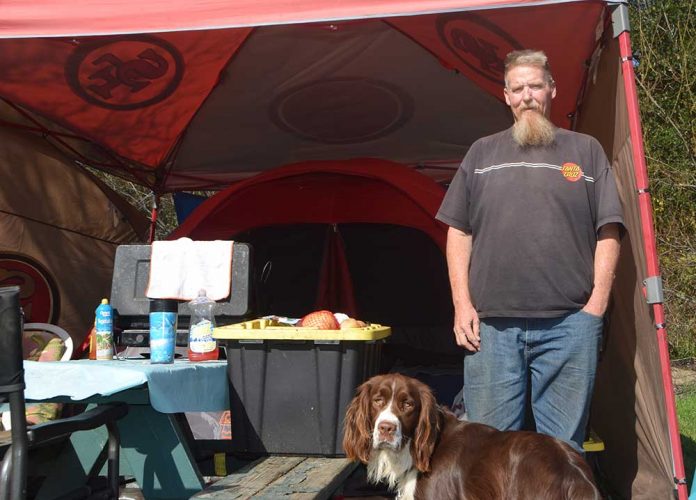On the northern part of San Benito County near Highway 101 at McAlpine Lake Campground, the tents of Almost Home offer as a stark contrast to the homeless encampments that pop up along the South Valley’s railroads and waterways.
The privately funded camp site represents a new and progressive way to temporarily give homeless people a safe place to stay.
Matt Schultz is one of four who stay at McAlpine these days. Inside Schultz’s tent, he has a mattress with a box spring, a heavy-duty sleeping bag. The tent itself is sheltered by a canopy and in front, serving as a kitchen/living room a campground picnic table has a place for his small propane stove.
“It’s safe and it has everything I need,” Schultz said. “There’s a place for me to shower and I don’t have to worry about my things being stolen.”
Almost Home is an entirely privately funded program managed by Dee Pearse, Program Manager for the Gilroy Compassion Center. During the peak season for Almost Home, typically the warmer months while temporary shelters like the Armory are open, the number of participants ranges up to about 15. During colder months, the outdoor tent population drops to about four.
This is in sharp contrast to the dozens of illegal temporary campsites that spring up around Gilroy. At one of these encampments visited last week is along Uvas Creek, a cluster of three tents lay nearby a chain link fence with a part rolled back to allow access to the area. The people camping here say they live in constant fear of being red-tagged, an official warning that is supposed to give them a three-day notice to vacate the area or risk having their possessions thrown away. According to them, this does not always happen.
“They need to be on their toes at that time,” Pearse said. “They need to have their stuff ready to move early in the morning, they need to vacate and they need to sit somewhere until the evening until they can come back. If the water district gets there and they’re not prepared, we have people who lose everything they have. They lose their IDs and their prescription pills.”
“I just had a client who got new dentures and he was so happy about that; and they lost that too,” she said.
The tale of the two camps illustrates the precarious existence of Gilroy’s homeless population. It also affords a view of what could be a viable mid-term solution to a problem that exasperates city police and fire personnel, business owners and residents concerned about safety.
“The camping program provides a stable place where they know they can be with access to sanitation,” Pearse said. “It’s stable. It gives them a place to decompress and then be able to work on a solution and that’s what this town needs. It needs a place where people can be. Instead of telling people they can’t be here (referring to an illegal campsite) tell them where they can be.”
Along the railroad tracks, there is another homeless camp, one large makeshift tent cluster that contains an unknown number of people. It is constructed of tarps and advertising banners held up by ropes and cords tied to a nearby fence line and tree, standing next to a small pup tent. The area is surrounded by trash, bikes, bike parts; it is boarded on one side by a fence line separating the rail line from nearby businesses. The rail track itself lies 10 feet nearby and is bisected by a crude trench dug to drain away rainwater.
“Honestly, I’ve given up, I don’t think I’m ever going to get a place,” said one homeless man living next to the railroad track. “I was told months ago that I would get a place. Then, nothing. I haven’t heard anything.”
Nearby underneath a railroad bridge, a tiny makeshift cave has been constructed by a couple in their thirties, made from large rocks found nearby which are held together by foam insulation. Miller Slough, which runs underneath the bridge, is dry now but memories of last year’s flooding are still fresh on minds of those who live underneath the bridge.
“Every time it rains I think about it,” said a woman, 35, who didn’t wish to be identified as she pointed to a spot which was the high water mark less than two feet from where they sleep.
Lake Campground is a privately owned campground which is used by both tent and TV campers. After a brief visual inspection of the RVs there, many with registrations that were expired since 2015, it appeared than many of the campers have been there on a long term basis.
Donations to the Compassion Center can be made online at gilroycompassioncenter.blogspot.com or on their Facebook page. Donations can also be dropped off directly at the Compassion Center at 370 Tompkins Court, Gilroy.















